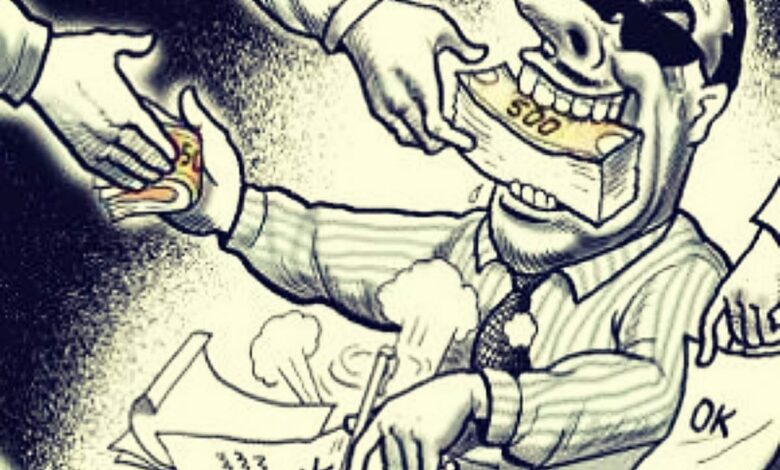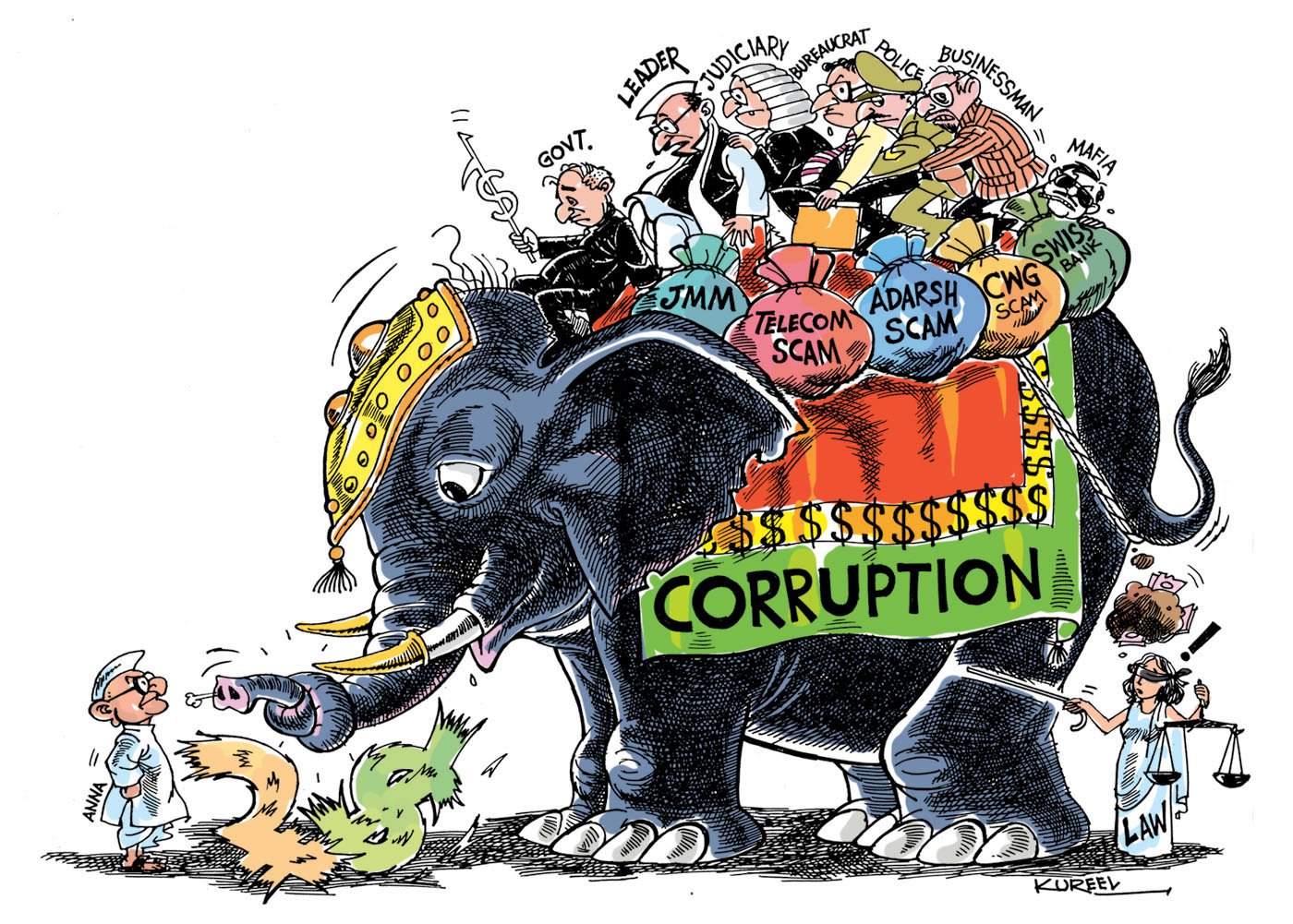High Taxes And Judiciary Are The Two Main Reasons For Corruption In India; Why Indian Citizens Have ‘No Faith’ In India’s Judicial System?
Corruption is a widespread problem that plagues India at all levels and across all segments; among the many factors contributing to corruption, high taxes and a corrupt judiciary stand out as two primary reasons. High taxes and the burden of taxation, especially on the middle-class segment, have been a long-standing issue. Similarly, the issue of corruption within the Indian Judiciary is a complex and deeply rooted problem that has persisted for years. It is a multi-faceted issue, prevalent not only in the lower courts but also at higher levels of the judicial system. While the Judiciary is meant to be the guardian of justice and the rule of law, the reality paints a different picture, marred by allegations of corruption and bribery. The Indian Judiciary has often been characterized as an institution with the bite to address corruption but lacking the full power to initiate stringent actions against it, primarily due to political manipulations and systemic challenges. Therefore, what is an Indian citizen to do, fight against, go with it or simply look the other way?

In India, the interwoven threads of high taxes, corruption at various levels, and the daily struggle of the ordinary citizen form a complex and often disheartening narrative.
These elements together bind to create a reality that is both disheartening and painful, where, on the one hand, the burden of excessive taxation often fuels corrupt practices, leaving the average Indian citizen to navigate a system that seems increasingly unresponsive to their needs and grievances and on the other the corrupt judicial system which offers no respite and no form of ‘real justice’ to ordinary citizens.
High taxes, though ostensibly designed to fuel the nation’s growth and finance public services, have paradoxically become a catalyst for corruption, further heightening the challenges faced by individuals striving to lead a productive, fruitful life but caught in the endless trap of higher-than-high taxes but limited opportunities, crumbling infrastructure and no solutions in sight.
In this intricate net of financial constraints, institutional corruption, and the pursuit of a better life, the plight of the ordinary citizen in India takes centre stage, albeit with no direction and nowhere to turn to.
The Corrupt Judiciary
The issue of corruption within the Indian Judiciary is a complex and deeply rooted problem that has persisted for years, so much so that it has become a long-standing, multi-faceted issue, encompassing not only the lower courts but also higher levels of the judicial system.
While the Judiciary is meant to be the guardian of justice and the rule of law, the reality paints a different picture, marred by allegations of corruption and bribery.
All-Time High Judicial Corruption at Lower Levels
At the lower court levels, the Judiciary in India is considered to be at the highest risk of corruption and bribes and irregular payments are often exchanged for favourable court decisions.
One alarming statistic from a 2006 survey conducted by Transparency International’s Global Corruption Barometer revealed that 8% of respondents who had contact with the Judiciary admitted to paying bribes to secure a positive decision in their legal cases.

Legal Course Or Justice Not For Ordinary Folks
If you are someone who has knocked at the courts in the hope of justice, no matter what kind of issue, from severe (murder, domestic violence, rape, sexual abuse etc.) to not so severe (theft, business or corporate theft, consumer complaints etc.) you know that you are in for the longest haul.
Inaccessibility: The Indian judicial system is notoriously slow, expensive, and often inaccessible to the common citizen. Litigation is costly, and extra money is frequently required to navigate the labyrinthine legal process.
Misuse of Power: Instances of judges issuing arrest warrants without proper verification and for personal gain are not unheard of. There are many instances of judges who have offered judicial favours in exchange for bribes, while others have demanded even sexual favours from litigants in return for favourable decisions.
Slow and Inefficient: With millions of cases pending, the Indian judicial system is plagued by delays and inefficiencies. There are chances that one may eventually die of old age, but the court decision may still be pending; hence, these conditions provide fertile ground for bribery, as individuals may seek to expedite or manipulate court judgments through illicit means.
People in India may eventually end up paying bribes for various reasons, including obtaining favourable judgments, speeding up the judicial process, handling non-case-related activities within the purview of the Judiciary, securing bail, and manipulating witnesses.

The Highly Influential Political Angle
The cumbersome impeachment process for judges, overseen by members of the Lok Sabha and the Rajya Sabha, often proves to be politically influenced and rarely leads to the removal of corrupt judges.
The Judiciary holds significant powers, including registering cases against public workers on charges of corruption and conducting inquiries and investigations into the actions of Union Ministers and Members of Parliament.
However, what is striking is the lack of inquiries into judicial corruption or allegations of a lack of independence within the Judiciary; the government has rarely been pressed on any connections it may have to the courts, allowing an atmosphere of impunity to persist.
Bribery and Political Interference
Judicial corruption in India manifests in two primary forms: political interference in the judicial process and bribery.
Even when evidence of corrupt practices surfaces, the pressure on judges to rule in favour of political interests remains intense; those judges who dare to refuse compliance often face swift and harsh political retaliation.
Bribery, on the other hand, permeates all levels of the judicial process; Judges may accept bribes to manipulate the timing of verdicts, approve or deny appeals, or simply decide cases in a particular manner.
Court officials are also known to coerce bribes in exchange for providing free services, and lawyers charge additional “fees” to expedite or delay cases.
The Extent of Corruption
A 2005 survey, the India Corruption Study conducted by Transparency International and the Delhi-based Centre for Media Studies, revealed the pervasive nature of corruption in India.
This comprehensive report, which covered 20 states and included interviews with service providers and users, disclosed that Indians paid around ₹21,068 crore as bribes while availing one of 11 public services; such revelations show the widespread nature of corruption within the country.

Challenges in the Judicial System
The sheer number of cases pending in the Indian judicial system, a staggering 26 million at the last count, indicates an overburdened and inefficient system.
With delays and inefficiencies rife in the system, it becomes an ideal breeding ground for middlemen who exploit these conditions to their advantage.
In the year preceding the survey, 59% of respondents admitted to paying bribes to lawyers, 5% to judges, and 30% to court officials.
Examples of Judicial Corruption
Numerous examples highlight the extent of judicial corruption in India; for instance, there have been instances where Metropolitan Magistrates issued bailable arrest warrants against individuals about whom they had no knowledge, in exchange for inducements.
Shockingly, a Metropolitan Magistrate in Ahmedabad issued bailable arrest warrants against the President of India in return for an inducement of ₹40,000; reports from Rajasthan revealed a judge who offered judicial favours in exchange for sexual favours from a litigant.
These instances have been reported in the media, but they often lead to little or no action; the legal system’s existing rules deter individuals from making allegations against sitting judges, as they can be charged and punished for contempt of court and this legal provision serves as a deterrent against more such instances coming to light.
Challenges in the Impeachment Process
The Indian Judiciary’s immunity is reinforced by a cumbersome impeachment process, which can only be initiated by members of the Lok Sabha and the Rajya Sabha.
There have been few attempts at impeachment in India, and the process is susceptible to political influence; the complex nature of this process was exemplified in the 1990s when a motion to impeach Justice V Ramaswami failed as Congress members of parliament abstained from voting.
The Judiciary plays a pivotal role in curbing corruption, as it has the authority to register cases against public workers on charges of corruption and investigate the actions of Union Ministers and Members of Parliament.
However, the question arises: Why has there been no inquiry into judicial corruption or its independence?
Why has the government not been held accountable for any connections it may have with the courts?
The Indian Judiciary Having the Bite, But Lacking the Power to Combat Corruption
The Judiciary in India is entrusted with the crucial role of interpreting the law, ensuring justice, and acting as a check and balance against corruption. It has the authority to register cases against public workers on charges of corruption and to investigate the actions of Union Ministers and Members of Parliament.
Political Manipulation: One of the most significant challenges faced by the Judiciary in India is political manipulation. While the Judiciary is meant to be an independent and impartial institution, political interests can significantly influence its decisions and actions.
The appointment of judges, especially at higher levels, can be subject to political considerations, impacting the Judiciary’s autonomy, and this has led to a reluctance to take stringent actions against corrupt politicians or officials who may have political backing.
Limited Legislative Authority: The Judiciary in India is not a law-making body; it can interpret and apply laws but cannot independently create new legislation to address evolving forms of corruption or strengthen anti-corruption measures.
The limitation places the Judiciary in a somewhat reactive position, as it relies on existing laws that may not be robust enough to combat new and innovative forms of corruption.
Complex Legal Procedures: Legal procedures in India can be lengthy, complex, and often bogged down by bureaucratic red tape, which slows down the judicial process, making it challenging to deliver timely and stringent actions against corruption, and lengthy court proceedings can allow corrupt practices to persist unchecked for extended periods.
Now, coming to the question of high taxes and its role in corruption
High taxes in the Indian context, the burden of taxation, especially on the middle segment of the citizens on income, goods, and services, has significantly increased the financial burden on individuals.
When taxpayers feel that taxes overburden them, they may resort to corrupt practices as a means to reduce their tax liabilities, and this may happen in many forms.
1. Tax Evasion: High taxes can incentivize individuals and businesses to underreport their income, inflate expenses, or engage in other fraudulent activities to reduce their tax liability. Tax evasion becomes a way to retain more income, which is seen as necessary due to excessive taxation.
2. Informal Economy: In an effort to avoid high taxes, many businesses and workers may choose to operate in the informal economy, where transactions often go unreported. This not only leads to a loss of potential tax revenue but also fosters an environment where corruption can thrive.
3. Bribery and Facilitation Payments: Individuals and businesses may feel compelled to pay bribes to tax officials to expedite the processing of their returns, secure tax refunds, or simply to avoid harassment during tax audits. These corrupt practices become a means to navigate the intricate tax system.
4. Psychological Toll: High taxes can take a psychological toll on individuals and businesses; when taxpayers perceive their tax burden as exorbitant, it can create a sense of injustice and unfairness.
This perception of injustice can lead to moral disengagement, where individuals justify engaging in corruption as a form of resistance or survival.
5. Rationalizing Corruption: High taxes can drive individuals to rationalize corrupt practices as a necessary means to cope with the perceived injustice of an excessively taxing system and may opine that they are merely getting back what was unfairly taken from them.

The Way Forward
Therefore, to combat this issue, the Indian government needs to reform the tax system, simplify tax regulations, and reduce the tax burden on individuals and businesses; a fair and efficient tax system can help reduce the incentives for corruption and promote compliance, ultimately benefiting the economy and society as a whole.
Judicial Corruption
Use of technology
- A review of how court records are handled and the introduction of modern tracking methods can eliminate much of the petty corruption existing in lower courts
- Court files can be computerized.
- Video recordings of court proceedings should be maintained.
2. Reduce the gap
- Provide alternative methods of dispute redressal to lighten the burden on courts
- Increase the number of judicial officers and the number of fast-track courts.
- Create a vigilance cell for the redressal of public grievances
3. Making the Judiciary accountable
- Judges must be subject to judicial review
- Judges must follow a code of conduct
- Bar associations must act against corrupt members
- A public body must keep an eye on the judicial system
- An Indian judicial service must be created
- The proposed National Judicial Commission should have powers to fire judges
- Judges should declare their assets and those of their family
The Last Bit,
Corruption in India is a multi-faceted issue with far-reaching consequences.
Judicial corruption erodes the public’s faith in the justice system, undermines the principles of justice and fairness, and perpetuates a culture of impunity.
The Indian Judiciary, while possessing the legal bite to address corruption, often faces limitations in its power to take stringent actions due to political manipulations, complex legal procedures, and resource constraints.
Addressing this problem necessitates comprehensive reforms in the judicial system, including increased transparency, accountability, and efficiency, as well as stricter oversight to weed out corruption at all levels.
Until these reforms are implemented, the stain of judicial corruption will continue to tarnish the Indian legal domain, depriving citizens of the justice they rightfully deserve.
Recognizing and addressing these challenges is vital for strengthening the role of the Judiciary in combating corruption effectively; an empowered and independent judiciary is essential for upholding the rule of law and ensuring that corruption is met with swift and stringent actions, regardless of political influence or bureaucratic hurdles.
Similarly, the Indian government needs to address the problem of an escalating tax burden on ordinary citizens with no real-time benefits that one can see as of now.





